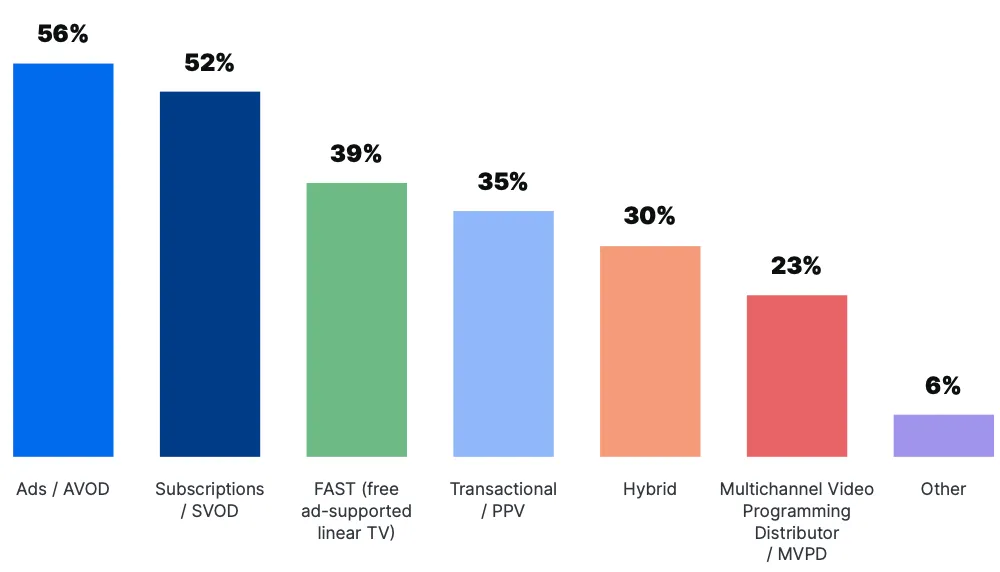FAST/AVOD Advertising Solutions: Accelerating Content Monetization for Profitable Business Growth
For enterprise users, choosing the right business model and monetization strategy is always the core issue to address. In the field of OTT (Over The Top) streaming media, video advertising can be considered one of the most mainstream ways to monetize streaming media content. In today's article, we will provide a detailed introduction to the business models and technical applications of streaming media advertising, and explain how to use Tencent MPS Stream Services to quickly achieve content monetization and help enterprises achieve profitability.
The Business Model of Streaming Media
The business models of streaming media have undergone various changes, primarily including the following methods:
- SVOD (Subscription Video): Users pay in advance for a subscription, allowing them to watch content for free within the subscription period without additional charges.
- TVOD (Transactional Video): Users pay per view or per transaction. TVOD typically does not require a subscription or personal profile; users only need to pay for the content they want to watch.
- AVOD (Advertising-based Video): Video content with advertisements. Users can watch video programs for free but need to view advertisements. Advertisers pay the content distribution platform for the opportunity to have their ads viewed. Streaming media platforms monetize and generate revenue through this model.
- FAST Channel (Free Ad-Supported Streaming TV): This is a popular product form and business model that emerged after SVOD/AVOD. FAST Channels provide ad-supported content in the form of live streaming. Users can watch the content of specific channels for free through free ad-supported streaming TV services.
Typically, streaming media platforms often support multiple models for users to choose from. Many streaming websites also employ a combination of several business models.

Comparison of Streaming Media monetization Methods (Data from Bitmovin)
When it comes to advertising, it involves how advertising is traded, and the key participants in advertising transactions include DSP (Demand Side Platform) and SSP (Supply Side Platform).
- DSP, Demand Side Platform, is the platform used by the demand side of advertising transactions, which includes advertisers or agencies. Through DSP, advertisers or agencies can place their ads. Additionally, DSPs can connect to various media resources, assisting advertisers in comprehensive and targeted marketing based on audience data analysis.
- SSP, Supply Side Platform, is the platform used by content publishers. It provides content resources and ad placements while integrating with advertising trading systems, ad networks, and multiple DSPs. SSPs help media publishers optimize the utilization efficiency of ad inventory.
DSP and SSP often achieve advertising transactions through advertising alliances such as AdNetwork or programmatic advertising trading platforms such as AdExchange.

Technical standards for Streaming Media
CSAI (Client-Side Ad Insertion) and SSAI (Server-Side Ad Insertion) both require the program to be able to recognize ad event markers, which can be implemented using standards such as SCTE-35, VAST, VMAP, and others.
In the article " What is SCTE-35 and VAST? ", the two methods of ad insertion, SCTE-35 and VAST, are explained in detail.
1. SCTE-35
SCTE-35 is a digital broadcasting standard developed by the Society of Cable Telecommunications Engineers (SCTE), which is used to insert and transmit time and event information in digital video broadcasting. The SCTE-35 standard defines a binary message format for identifying upcoming ad insertion points and ad termination points within a video stream. This allows ads to be seamlessly inserted and removed within the video stream without affecting the continuity of the video.
2. VAST
VAST (Video Ad Serving Template), VPAID (Video Player-Ad Interface Definition), and VMAP (Video Multiple Ad Playlist) are the primary advertising service standards established by the Interactive Advertising Bureau (IAB). These standards enable the seamless operation of the entire advertising ecosystem in the creation, editing, delivery, and tracking of ads.
VAST supports multiple types of ads. The most common type is Linear Ads, where the video ad is displayed in the same area as the video content but with different durations. In on-demand scenarios, pre-roll ads are displayed before the video content starts. Additionally, there are mid-roll and post-roll ads.
VMAP, on the other hand, serves as a protocol for managing multiple ad playlists. It allows content creators (those who create the video) to specify the positions for ad breaks. VMAP is primarily used in VOD (Video on Demand) ad insertion scenarios, especially when the VOD source lacks SCTE-35 ad event markers. With VMAP, the ad insertion system is informed about where to insert ads within the on-demand video file.
Monetize Streaming Media with Tencent MPS Stream
Based on these standards, Tencent MPS Stream Services enables dynamic ad insertion for Live Streaming and VOD, as well as the popular streaming media advertising format FAST (Free Ad-Supported TV) Channel through the combination of Channel Linear Assembly and Server-Side Ad Insertion.
1. SSAI in Stream Services
StreamPackage in Stream Services supports integration with ad service platforms that adhere to the VAST/VMAP standards, such as Google AdManager, AdSpeed, FreeWheel, SpringServe (Magnite), and more. Through these ad platforms, users can obtain the best ads through real-time bidding (RTB) or ad networks and insert them into specified positions within the streaming media using StreamPackage's SSAI (Server-Side Ad Insertion) functionality.
2. Live Ad
Stream Services supports two methods for ad insertion in live streaming media. Firstly, it can pass through ad markers (SCTE-35 passthrough) when using protocols like MPEG-TS, where the source stream already contains SCTE-35 ad markers. Stream Services generates corresponding protocol tags in HLS/DASH playback protocols. Secondly, it provides a scheduled arrangement feature to insert desired SCTE-35 events at specified times or events.
By utilizing the SSAI functionality mentioned earlier, dynamic and personalized ad replacement can be achieved within the live streaming media.
3. AVOD
Stream Services also supports dynamic ad insertion in VOD streaming. Unlike live streaming, VOD sources may not have SCTE-35 markers. In such cases, ADS can return VMAP-formatted data to determine the positions for ad insertion (e.g., inserting ads before or after all VOD videos). The server-side can then insert the ad video file's manifest into the VOD source's manifest based on the ad insertion positions, enabling server-side ad insertion. After configuring the relevant SSAI settings, if CDN distribution is required, appropriate origin rules can be set in the CDN configuration.
4. FAST Channel
Stream Services can also be used to build a FAST Channel platform that includes capabilities such as media asset management, channel linear assembly, dynamic ad insertion, distribution, and analytics. The simplified workflow is depicted in the following diagram:
4.1 Media Asset Management
Firstly, the platform needs to manage media assets or resources, which can be on-demand files stored in the cloud or live streaming media being distributed in real-time. For VOD sources, users can upload their video files through Tencent VOD (Video on Demand) or COS (Cloud Object Storage) and then utilize the media processing capabilities in VOD or MPS for transcoding and multi-bitrate packaging. For live sources, Stream Services' StreamLive and StreamPackage can be used for the transmission, transcoding, and packaging of live streaming media, providing origin server functionality.
4.2 Linear Channel Assembly
One of the core functionalities of linear channel assembly is to arrange VOD sources (HLS/DASH) stored in multiple locations in the specified order to create a live stream. It's important to note that linear channel assembly only handles the manifest and doesn't process any media segments. During playback, the system directly retrieves the segments from their respective sources.
Through manifest linear assembly, multiple live or VOD sources can be arranged and organized in a linear timeline to create a single output. This approach allows for the reuse of transcoding and storage resources, resulting in significant cost savings for media platforms. Linear channel assembly consists of several components, including data source management, channel management, and program management.
- Data source management: Firstly, data source information needs to be created. Once a source is created, the system immediately pulls the manifest file and caches it. The system checks the availability and content compliance of the source and provides prompts on the console.
- Channel management: A channel represents a linear output. You can loop a VOD source in a channel or linearly assemble multiple VOD or live streaming media into a channel for output. Once a channel is started, programs will continue to be output without any time limit until the channel is stopped.
- Program management: Program management involves configuring the media assets to be played at specified times or events within a channel. In a linear channel, it is common to specify opening or transition animations (slate) to fill gaps between programs. Users can also choose to add advertisements and specify the expected ad duration between multiple programs.
With the linear channel assembly capabilities mentioned earlier, users can "linearly assemble" media assets into streaming channels and output them. During the linear channel assembly phase, ad markers can be inserted at any position within a program.
4.3 Dynamic Ad Insertion
Through the SSAI (Server-Side Ad Insertion) feature, streaming media content with dynamic ads can be achieved. By combining intelligent recommendation and ad decision services, targeted ad delivery based on user's geographical location, interests, and other factors becomes possible.
4.4 Distribution
Distribution can be achieved through CDN (Content Delivery Network), enabling playback for users across multiple regions and platforms. By caching the segmented content of streaming media on servers closest to the users, CDN reduces loading time and network latency, providing a better viewing experience.
4.5 User Statistics and Analytics
After ad delivery, it is important to understand the effectiveness of the ad placements and make corresponding strategy adjustments. Real-time data analytics tools can track audience behavior, including playback statistics at the channel level. This helps channel owners understand what is effective and what is not. Such data provides insights for future content and ad placement decisions, attracting more advertisers and increasing ad exposure, thereby boosting the revenue of the streaming media platform.
Conclusion
Tencent MPS Stream Services FAST/AVOD Advertising Solution provides comprehensive features and tools to help businesses innovate their revenue models, enhance user experience, and increase advertising revenue. If you are interested in this solution, please feel free to Contact Us, and we will provide further information and support.

